Stewart J. Calculus
Подождите немного. Документ загружается.

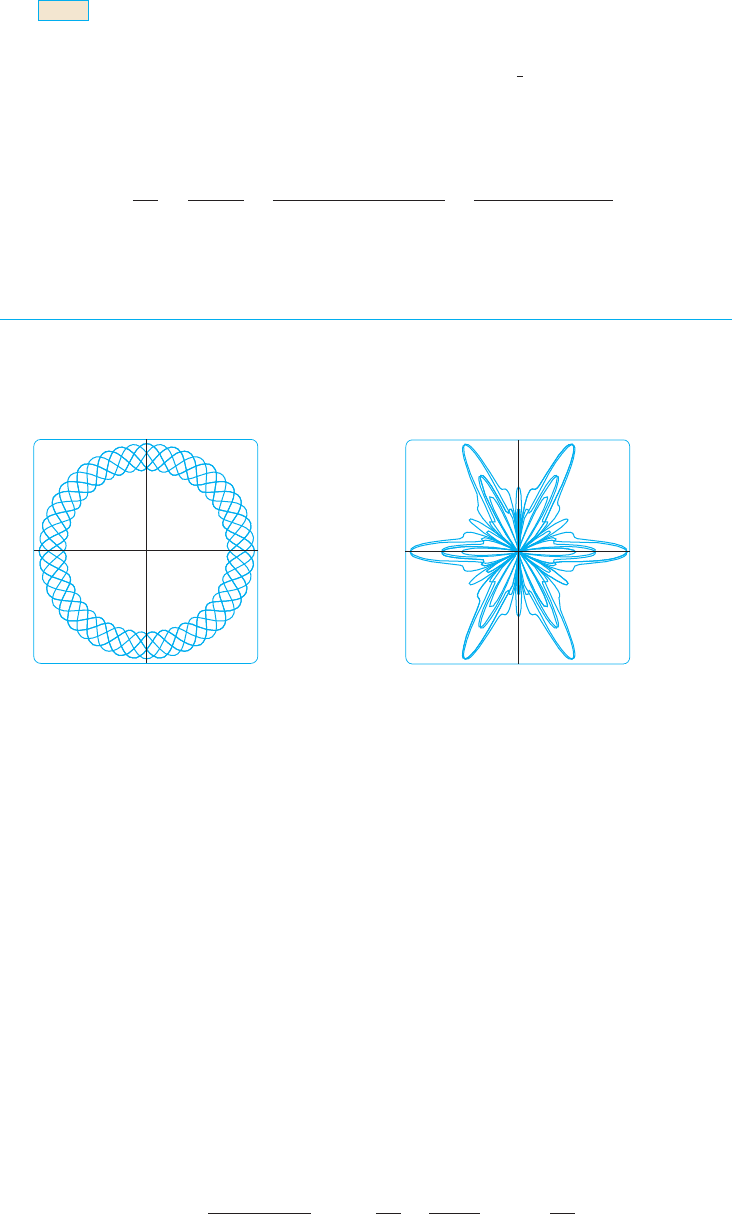
Instead of having to remember Equation 3, we could employ the method used
to derive it. For instance, in Example 9 we could have written
Then we would have
which is equivalent to our previous expression.
GRAPHING POLAR CURVES WITH GRAPHING DEVICES
Although it’s useful to be able to sketch simple polar curves by hand, we need to use a
graphing calculator or computer when we are faced with a curve as complicated as the ones
shown in Figures 16 and 17.
Some graphing devices have commands that enable us to graph polar curves directly.
With other machines we need to convert to parametric equations first. In this case we take
the polar equation and write its parametric equations as
Some machines require that the parameter be called rather than .
EXAMPLE 10 Graph the curve .
SOLUTION Let’s assume that our graphing device doesn’t have a built-in polar graphing
command. In this case we need to work with the corresponding parametric equations,
which are
In any case, we need to determine the domain for . So we ask ourselves: How many
complete rotations are required until the curve starts to repeat itself? If the answer is
, then
sin
8"
!
& 2n
#
#
5
! sin
%
8
!
5
&
16n
#
5
&
! sin
8
!
5
n
!
y ! r sin
!
! sin"8
!
!5# sin
!
x ! r cos
!
! sin"8
!
!5# cos
!
r ! sin"8
!
!5#
!
t
y ! r sin
!
! f "
!
# sin
!
x ! r cos
!
! f "
!
# cos
!
r ! f "
!
#
F I G U R E 1 7
r=sin@(1.2¨)+cos#(6¨)
1.7
_1.7
_1.9 1.9
F I G U R E 1 6
r=sin@(2.4¨)+cos$(2.4¨)
1
_1
_1 1
dy
dx
!
dy!d
!
dx!d
!
!
cos
!
& 2 sin
!
cos
!
%sin
!
& cos 2
!
!
cos
!
& sin 2
!
%sin
!
& cos 2
!
y ! r sin
!
! "1 & sin
!
# sin
!
! sin
!
& sin
2
!
x ! r cos
!
! "1 & sin
!
# cos
!
! cos
!
&
1
2
sin 2
!
NOTE
682
|| ||
CHAPTER 11 PARAMETRIC EQUATIONS AND POLAR COORDINATES
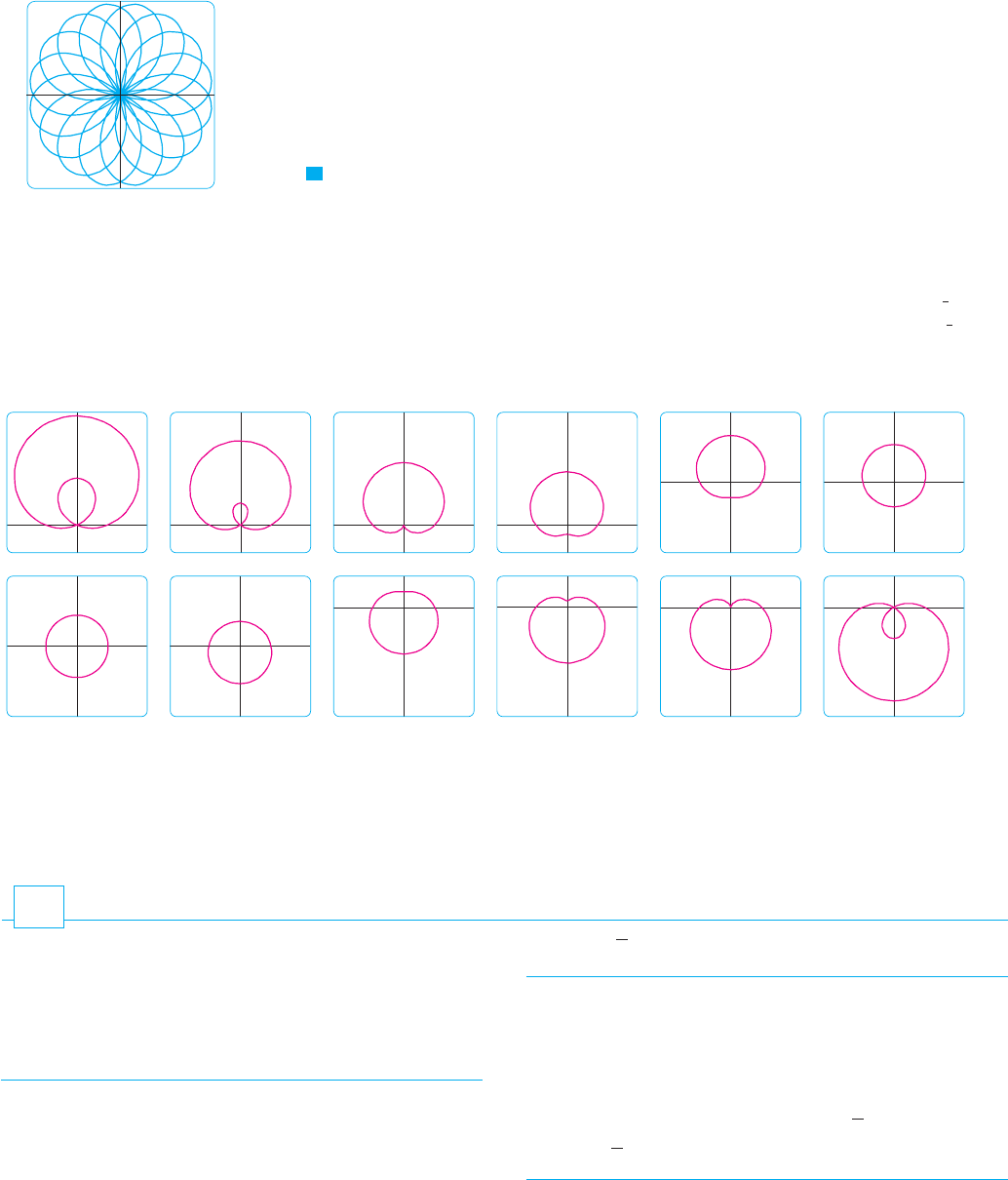
and so we require that be an even multiple of . This will first occur when
. Therefore we will graph the entire curve if we specify that .
Switching from to , we have the equations
and Figure 18 shows the resulting curve. Notice that this rose has 16 loops.
M
EXAMPLE 11 Investigate the family of polar curves given by . How
does the shape change as changes? (These curves are called limaçons, after a French
word for snail, because of the shape of the curves for certain values of .)
SOLUTION Figure 19 shows computer-drawn graphs for various values of . For there
is a loop that decreases in size as decreases. When the loop disappears and the
curve becomes the cardioid that we sketched in Example 7. For between 1 and the
cardioid’s cusp is smoothed out and becomes a “dimple.” When decreases from to ,
the limaçon is shaped like an oval. This oval becomes more circular as , and when
the curve is just the circle .
The remaining parts of Figure 19 show that as becomes negative, the shapes change
in reverse order. In fact, these curves are reflections about the horizontal axis of the corre-
sponding curves with positive .
M
c
c
F I G U R E 1 9
Members of the family o
f
limaçons r=1+csin¨
c=2.5
c=0 c=_0.2
c=_0.5 c=_0.8 c=_1
c=_2
c=1.7
c=1 c=0.7 c=0.5 c=0.2
r ! 1c ! 0
c l 0
0
1
2
c
1
2
c
c ! 1c
c $ 1c
c
c
r ! 1 & c sin
!
V
0 ' t ' 10
#
y ! sin"8t!5# sin tx ! sin"8t!5# cos t
t
!
0 '
!
' 10
#
n ! 5
#
16n
#
!5
SECTION 11.3 POLAR COORDINATES
|| ||
683
1
_1
_1 1
F I G U R E 1 8
r=sin(8¨/5)
N In Exercise 55 you are asked to prove analyti-
cally what we have discovered from the graphs
in Figure 19.
4. (a) (b) (c)
5–6 The Cartesian coordinates of a point are given.
(i) Find polar coordinates of the point, where and
.
(ii) Find polar coordinates of the point, where and
.
5. (a) (b)
6. (a) (b) "1, %2#
(
3
s
3
, 3
)
(
%1,
s
3
)
"2, %2#
0 '
!
"
2
#
r
"
0"r,
!
#
0 '
!
"
2
#
r $ 0"r,
!
#
"2, %7
#
!6#"1, 5
#
!2#
(
%
s
2
, 5
#
!4
)
1–2 Plot the point whose polar coordinates are given. Then find
two other pairs of polar coordinates of this point, one with
and one with .
1. (a) (b) (c)
2. (a) (b) (c)
3– 4 Plot the point whose polar coordinates are given. Then find
the Cartesian coordinates of the point.
3. (a) (b) (c) "%2, 3
#
!4#
(
2, %2
#
!3
)
"1,
#
#
"1, %1#"%3,
#
!6#"1, 7
#
!4#
"%1,
#
!2#"1, %3
#
!4#"2,
#
!3#
r
"
0
r $ 0
E X E R C I S E S
11.3
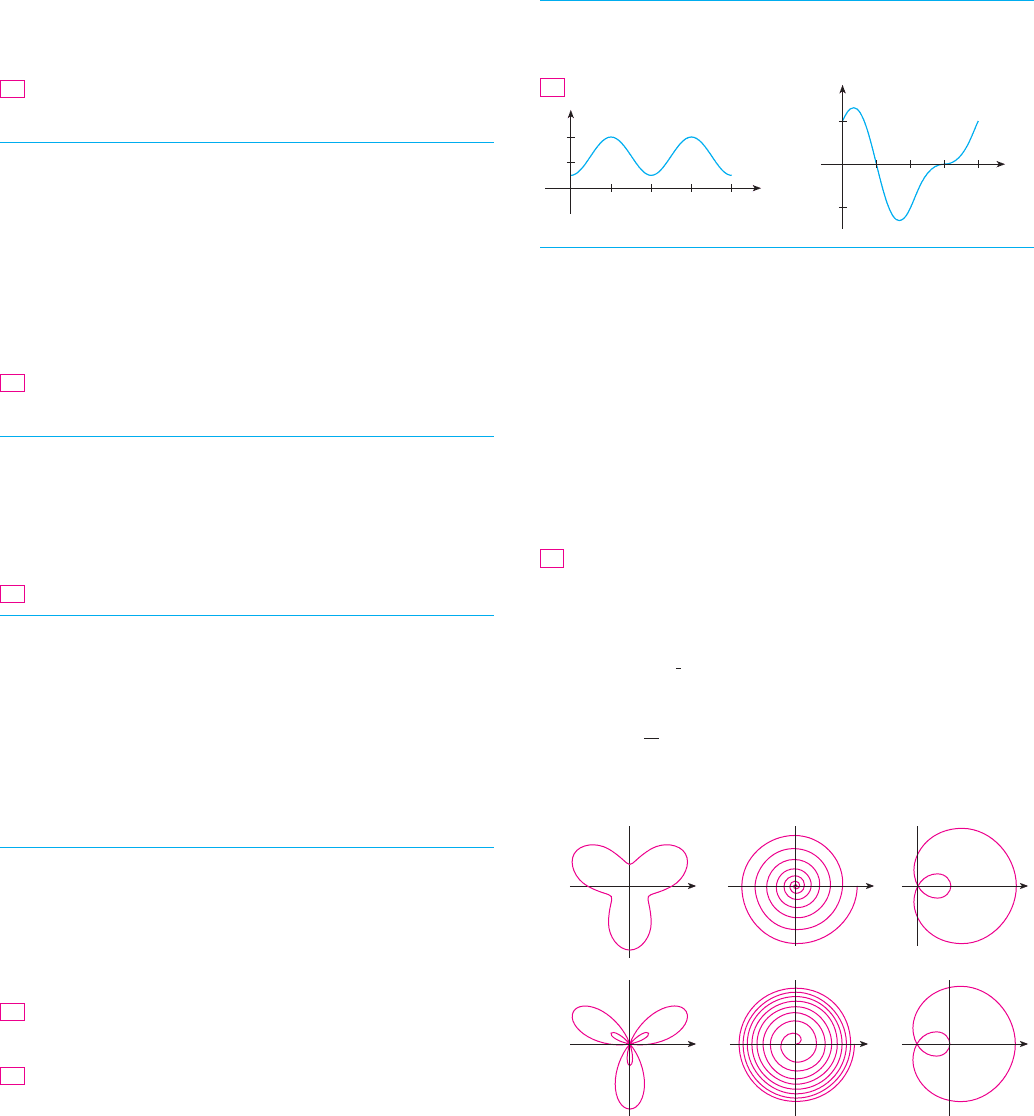
7–12 Sketch the region in the plane consisting of points whose
polar coordinates satisfy the given conditions.
7.
8.
,
9. ,
10. ,
,
12. ,
13. Find the distance between the points with polar coordinates
and .
14. Find a formula for the distance between the points with polar
coordinates and .
15–20 Identify the curve by finding a Cartesian equation for the
curve.
15. 16.
18.
19. 20.
21–26 Find a polar equation for the curve represented by the given
Cartesian equation.
21. 22.
23. 24.
26.
27–28 For each of the described curves, decide if the curve would
be more easily given by a polar equation or a Cartesian equation.
Then write an equation for the curve.
27. (a) A line through the origin that makes an angle of with
the positive -axis
(b) A vertical line through the point
28. (a) A circle with radius 5 and center
(b) A circle centered at the origin with radius 4
29– 48 Sketch the curve with the given polar equation.
29. 30.
31. 32.
33.
, 34.
, 36. ,
37. 38.
40.
41. 42.
r ! 2 & sin
!
r ! 1 % 2 sin
!
r ! 3 cos 6
!
r ! 2 cos 4
!
39.
r ! cos 5
!
r ! 4 sin 3
!
!
) 1r ! ln
!
!
) 0r !
!
35.
r ! 1 % 3 cos
!
!
) 0r ! 2"1 % sin
!
#
r ! %3 cos
!
r ! sin
!
r
2
% 3r & 2 ! 0
!
! %
#
!6
"2, 3#
"3, 3#
x
#
!6
xy ! 4x
2
& y
2
! 2cx
25.
x & y ! 9x ! %y
2
x
2
& y
2
! 9x ! 3
r ! tan
!
sec
!
r ! csc
!
r ! 2 sin
!
& 2 cos
!
r ! 3 sin
!
17.
r cos
!
! 1r ! 2
"r
2
,
!
2
#"r
1
,
!
1
#
"4, 2
#
!3#"2,
#
!3#
#
'
!
' 2
#
r ) 1
5
#
!3 '
!
' 7
#
!32
"
r
"
3
11.
3
#
!4
"
!
"
5
#
!42
"
r ' 5
%
#
!2 '
!
"
#
!60 ' r
"
4
#
!3 '
!
' 2
#
!3r ) 0
1 ' r ' 2
684
|| ||
CHAPTER 11 PARAMETRIC EQUATIONS AND POLAR COORDINATES
43. 44.
45. 46.
47. 48.
49–50 The figure shows the graph of as a function of in Carte-
sian coordinates. Use it to sketch the corresponding polar curve.
50.
51. Show that the polar curve (called a conchoid)
has the line as a vertical asymptote by showing that
. Use this fact to help sketch the conchoid.
52. Show that the curve (also a conchoid) has the
line as a horizontal asymptote by showing that
. Use this fact to help sketch the conchoid.
53. Show that the curve (called a cissoid of
Diocles) has the line as a vertical asymptote. Show also
that the curve lies entirely within the vertical strip .
Use these facts to help sketch the cissoid.
54. Sketch the curve .
(a) In Example 11 the graphs suggest that the limaçon
has an inner loop when . Prove
that this is true, and find the values of that correspond to
the inner loop.
(b) From Figure 19 it appears that the limaçon loses its dimple
when . Prove this.
56. Match the polar equations with the graphs labeled I–VI. Give
reasons for your choices. (Don’t use a graphing device.)
(a) (b)
(c) (d)
(e) (f)
I II III
IV V VI
r ! 1 & 2 sin 3
!
r ! 2 & sin 3
!
r ! 1 & 2 cos
!
r ! cos"
!
!3#
r !
!
2
, 0 '
!
' 16
#
r !
s
!
, 0 '
!
' 16
#
c !
1
2
!
$
c
$
$ 1r ! 1 & c sin
!
55.
"x
2
& y
2
#
3
! 4x
2
y
2
0 ' x
"
1
x ! 1
r ! sin
!
tan
!
lim
r l *(
y ! %1
y ! %1
r ! 2 % csc
!
lim
r l *(
x ! 2
x ! 2
r ! 4 & 2 sec
!
¨
r
0
π 2π
1
2
¨
r
0
π 2π
2
_2
49.
!
r
r ! 1 & 2 cos"
!
!2#r ! 1 & 2 cos 2
!
r
2
!
! 1r ! 2 cos"3
!
!2#
r
2
! cos 4
!
r
2
! 9 sin 2
!
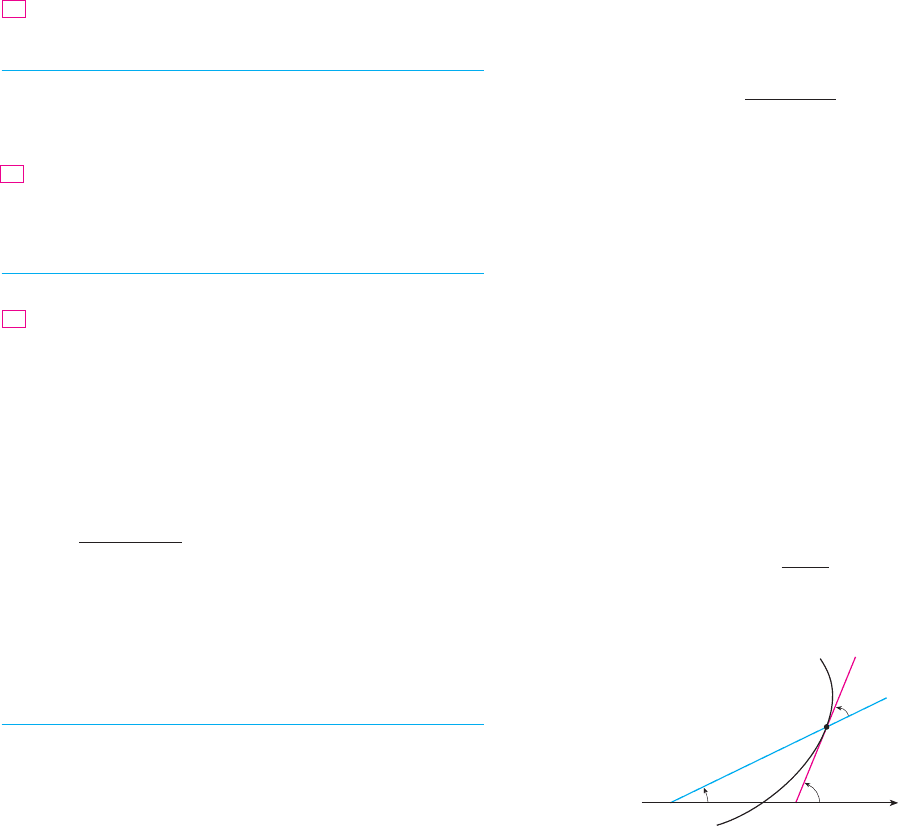
SECTION 11.3 POLAR COORDINATES
|| ||
685
;
80. A family of curves is given by the equations ,
where is a real number and is a positive integer. How does
the graph change as increases? How does it change as
changes? Illustrate by graphing enough members of the fam-
ily to support your conclusions.
;
81. A family of curves has polar equations
Investigate how the graph changes as the number changes.
In particular, you should identify the transitional values of
for which the basic shape of the curve changes.
;
82. The astronomer Giovanni Cassini (1625 –1712) studied the
family of curves with polar equations
where and are positive real numbers. These curves are
called the ovals of Cassini even though they are oval shaped
only for certain values of and . (Cassini thought that these
curves might represent planetary orbits better than Kepler’s
ellipses.) Investigate the variety of shapes that these curves
may have. In particular, how are and related to each other
when the curve splits into two parts?
83. Let be any point (except the origin) on the curve .
If is the angle between the tangent line at and the radial
line , show that
[Hint: Observe that in the figure.]
84. (a) Use Exercise 83 to show that the angle between the tan-
gent line and the radial line is at every point on
the curve .
;
(b) Illustrate part (a) by graphing the curve and the tangent
lines at the points where and .
(c) Prove that any polar curve with the property that
the angle between the radial line and the tangent line is
a constant must be of the form , where and
are constants.
kCr ! Ce
k
!
+
r ! f "
!
#
#
!2
!
! 0
r ! e
!
+
!
#
!4
O
P
ÿ
¨
˙
r=f(¨)
+
!
,
%
!
tan
+
!
r
dr!d
!
OP
P
+
r ! f "
!
#P
ca
ca
ca
r
4
% 2c
2
r
2
cos 2
!
& c
4
% a
4
! 0
a
a
r !
1 % a cos
!
1 & a cos
!
cn
nc
r ! 1 & c sin n
!
57–62 Find the slope of the tangent line to the given polar curve
at the point specified by the value of .
57. , 58. ,
, 60. ,
61. , 62. ,
63–68 Find the points on the given curve where the tangent line
is horizontal or vertical.
64.
65. 66.
67. 68.
Show that the polar equation , where
, represents a circle, and find its center and radius.
70. Show that the curves and intersect at
right angles.
;
71–76 Use a graphing device to graph the polar curve. Choose
the parameter interval to make sure that you produce the entire
curve.
71. (nephroid of Freeth)
72. (hippopede)
73. (butterfly curve)
74.
75.
76.
;
77. How are the graphs of and
related to the graph of ?
In general, how is the graph of related to the
graph of ?
;
78. Use a graph to estimate the -coordinate of the highest points
on the curve . Then use calculus to find the exact
value.
;
79. (a) Investigate the family of curves defined by the polar equa-
tions , where is a positive integer. How is the
number of loops related to ?
(b) What happens if the equation in part (a) is replaced by
?r !
$
sin n
!
$
n
nr ! sin n
!
r ! sin 2
!
y
r ! f "
!
#
r ! f "
!
%
-
#
r ! 1 & sin
!
r ! 1 & sin"
!
%
#
!3#
r ! 1 & sin"
!
%
#
!6#
r ! cos"
!
!2# & cos"
!
!3#
r ! 2 % 5 sin"
!
!6#
r ! sin
2
"4
!
# & cos"4
!
#
r ! e
sin
!
% 2 cos"4
!
#
r !
s
1 % 0.8 sin
2
!
r ! 1 & 2 sin"
!
!2#
r ! a cos
!
r ! a sin
!
ab " 0
r ! a sin
!
& b cos
!
69.
r
2
! sin 2
!
r ! 2 & sin
!
r ! e
!
r ! 1 & cos
!
r ! 1 % sin
!
r ! 3 cos
!
63.
!
!
#
!3r ! 1 & 2 cos
!
!
!
#
!4r ! cos 2
!
!
!
#
r ! cos"
!
!3#
!
!
#
r ! 1!
!
59.
!
!
#
!3r ! 2 % sin
!
!
!
#
!6r ! 2 sin
!
!
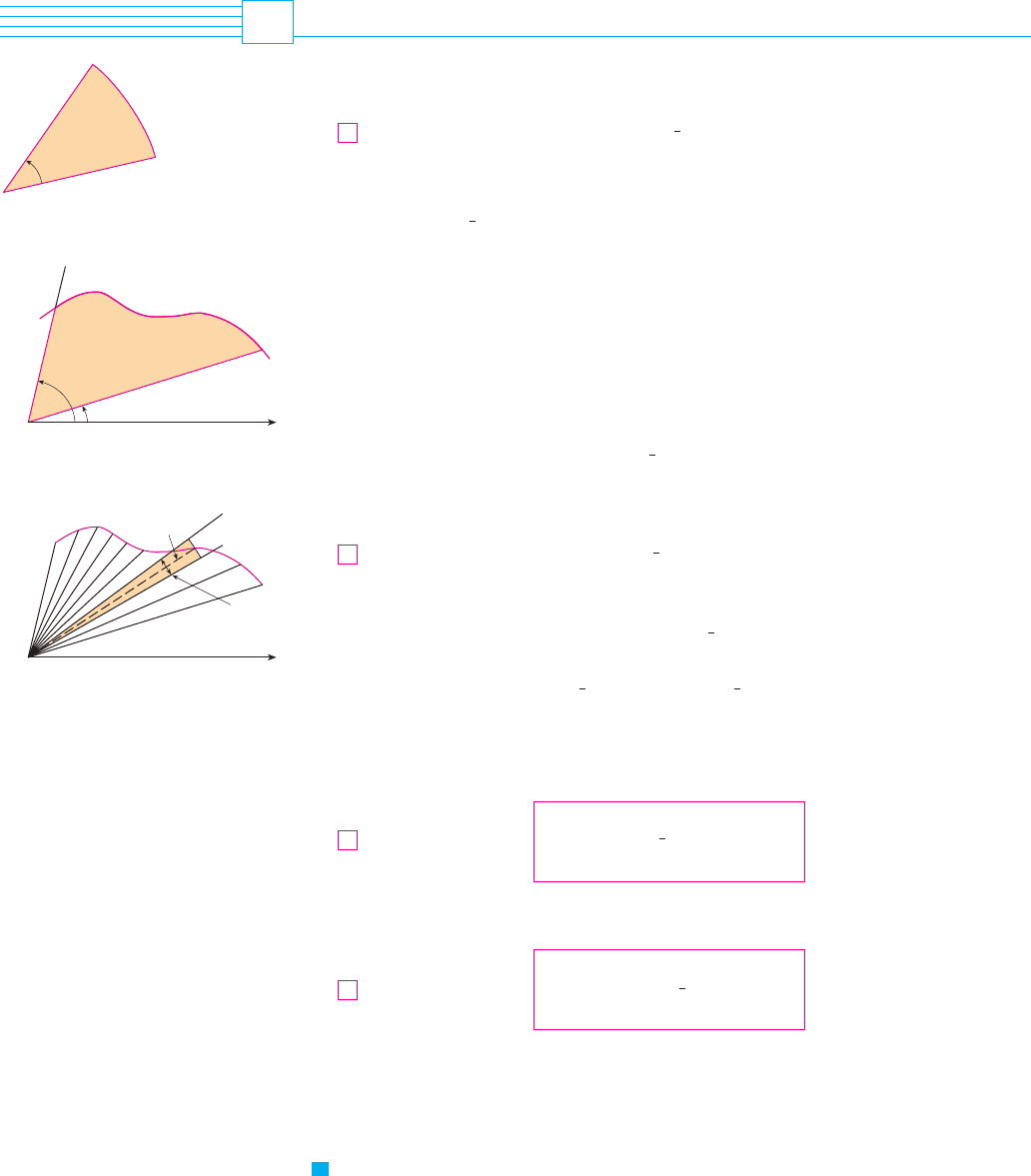
AREAS AND LENGTHS IN POLAR COORDINATES
In this section we develop the formula for the area of a region whose boundary is given by
a polar equation. We need to use the formula for the area of a sector of a circle
where, as in Figure 1, is the radius and is the radian measure of the central angle.
Formula 1 follows from the fact that the area of a sector is proportional to its central angle:
. (See also Exercise 35 in Section 8.3.)
Let be the region, illustrated in Figure 2, bounded by the polar curve
and by the rays and , where is a positive continuous function and where
. We divide the interval into subintervals with endpoints , ,
, . . . , and equal width . The rays then divide into smaller regions with
central angle . If we choose in the subinterval , then the area
of the th region is approximated by the area of the sector of a circle with central angle
and radius
.
(See Figure 3.)
Thus from Formula 1 we have
and so an approximation to the total area of is
It appears from Figure 3 that the approximation in (2) improves as . But the sums
in (2) are Riemann sums for the function , so
It therefore appears plausible (and can in fact be proved) that the formula for the area of
the polar region is
Formula 3 is often written as
with the understanding that . Note the similarity between Formulas 1 and 4.
When we apply Formula 3 or 4, it is helpful to think of the area as being swept out by
a rotating ray through that starts with angle and ends with angle .
EXAMPLE 1 Find the area enclosed by one loop of the four-leaved rose .
SOLUTION The curve was sketched in Example 8 in Section 11.3. Notice from
Figure 4 that the region enclosed by the right loop is swept out by a ray that rotates from
r ! cos 2
!
r ! cos 2
!
V
baO
r ! f !
!
"
A !
y
b
a
1
2
r
2
d
!
4
A !
y
b
a
1
2
# f !
!
"$
2
d
!
3
!
A
lim
n l "
%
n
i!1
1
2
# f !
!
i
*
"$
2
#
!
!
y
b
a
1
2
# f !
!
"$
2
d
!
t!
!
" !
1
2
# f !
!
"$
2
n l "
A &
%
n
i!1
1
2
# f !
!
i
*
"$
2
#
!
2
!A
#A
i
&
1
2
# f !
!
i
*
"$
2
#
!
f !
!
i
*
"#
!
i#A
i
#
!
i$1
,
!
i
$ith
!
i
*
#
!
!
!
i
$
!
i$1
n!
!
!
!
i
#
!
!
n
!
2
!
1
!
0
#a, b$0
%
b $ a & 2
'
f
!
! b
!
! a
r ! f !
!
"!
A ! !
!
'2
'
"
'
r
2
!
1
2
r
2
!
!
r
A !
1
2
r
2
!
1
11.4
686
|| ||
CHAPTER 11 PARAMETRIC EQUATIONS AND POLAR COORDINATES
¨
r
F I G U R E 1
F I G U R E 2
O
¨=b
b
¨=a
r=f(¨)
a
!
O
¨=b
¨=a
¨=¨
i-1
¨=¨
i
Ψ
f(¨
i
*
)
F I G U R E 3
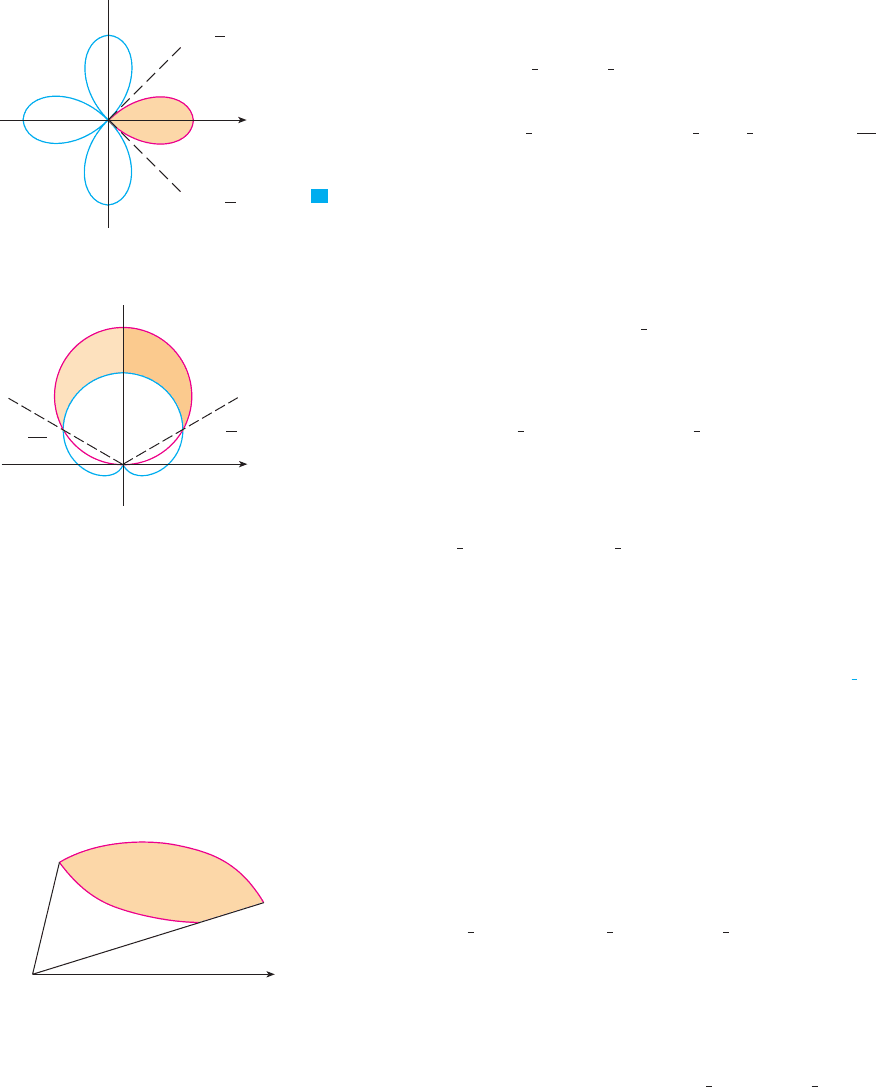
to . Therefore Formula 4 gives
M
EXAMPLE 2 Find the area of the region that lies inside the circle and
outside the cardioid .
SOLUTION The cardioid (see Example 7 in Section 11.3) and the circle are sketched in
Figure 5 and the desired region is shaded. The values of and in Formula 4 are deter-
mined by finding the points of intersection of the two curves. They intersect when
, which gives , so , . The desired area can be
found by subtracting the area inside the cardioid between and from
the area inside the circle from to . Thus
Since the region is symmetric about the vertical axis , we can write
[
because
]
M
Example 2 illustrates the procedure for finding the area of the region bounded by two
polar curves. In general, let be a region, as illustrated in Figure 6, that is bounded by
curves with polar equations , , , and , where
and . The area of is found by subtracting the area inside
from the area inside , so using Formula 3 we have
|
CAUTION
The fact that a single point has many representations in polar coordinates
sometimes makes it difficult to find all the points of intersection of two polar curves.
For instance, it is obvious from Figure 5 that the circle and the cardioid have three
points of intersection; however, in Example 2 we solved the equations and
and found only two such points, and . The origin is also
a point of intersection, but we can’t find it by solving the equations of the curves because
the origin has no single representation in polar coordinates that satisfies both equations.
Notice that, when represented as or , the origin satisfies and so it
lies on the circle; when represented as , it satisfies and so it lies on
the cardioid. Think of two points moving along the curves as the parameter value
increases from 0 to . On one curve the origin is reached at and ; on the
!
!
'
!
! 02
'
!
r ! 1 ( sin
!
!0, 3
'
'2"
r ! 3 sin
!
!0,
'
"!0, 0"
(
3
2
, 5
'
'6
)(
3
2
,
'
'6
)
r ! 1 ( sin
!
r ! 3 sin
!
!
1
2
y
b
a
!# f !
!
"$
2
$ #t!
!
"$
2
" d
!
A !
y
b
a
1
2
# f !
!
"$
2
d
!
$
y
b
a
1
2
#t!
!
"$
2
d
!
r ! f !
!
"
r ! t!
!
"!A0
%
b $ a & 2
'
f !
!
" ) t!
!
" ) 0
!
! b
!
! ar ! t!
!
"r ! f !
!
"
!
! 3
!
$ 2 sin 2
!
( 2 cos
!
]
'
'6
'
'2
!
'
sin
2
!
!
1
2
!1 $ cos 2
!
" !
y
'
'2
'
'6
!3 $ 4 cos 2
!
$ 2 sin
!
" d
!
!
y
'
'2
'
'6
!8 sin
2
!
$ 1 $ 2 sin
!
" d
!
A ! 2
(
1
2
y
'
'2
'
'6
9 sin
2
!
d
!
$
1
2
y
'
'2
'
'6
!1 ( 2 sin
!
( sin
2
!
"
d
!
)
!
!
'
'2
A !
1
2
y
5
'
'6
'
'6
!3 sin
!
"
2
d
!
$
1
2
y
5
'
'6
'
'6
!1 ( sin
!
"
2
d
!
5
'
'6
'
'6
!
! 5
'
'6
!
!
'
'6
5
'
'6
!
!
'
'6sin
!
!
1
2
3 sin
!
! 1 ( sin
!
ba
r ! 1 ( sin
!
r ! 3 sin
!
V
!
1
2
[
!
(
1
4
sin 4
!
]
0
'
'4
!
'
8
!
y
'
'4
0
1
2
!1 ( cos 4
!
" d
!
!
y
'
'4
0
cos
2
2
!
d
!
A !
y
'
'4
$
'
'4
1
2
r
2
d
!
!
1
2
y
'
'4
$
'
'4
cos
2
2
!
d
!
!
!
'
'4
!
! $
'
'4
SECTION 11.4 AREAS AND LENGTHS IN POLAR COORDINATES
|| ||
687
r=cos2¨
¨=
π
4
¨=_
π
4
F I G U R E 4
F I G U R E 5
O
¨=
5π
6
¨=
π
6
r=3sin¨
r=1+sin¨
O
¨=b
¨=a
r=f(¨)
!
r=g(¨)
F I G U R E 6

other curve it is reached at . The points don’t collide at the origin because they
reach the origin at different times, but the curves intersect there nonetheless.
Thus, to find all points of intersection of two polar curves, it is recommended that you
draw the graphs of both curves. It is especially convenient to use a graphing calculator or
computer to help with this task.
EXAMPLE 3 Find all points of intersection of the curves and .
SOLUTION If we solve the equations and , we get and, there-
fore, , , , . Thus the values of between 0 and that sat-
isfy both equations are , , , . We have found four points of
intersection: , , and .
However, you can see from Figure 7 that the curves have four other points of inter-
section—namely, , , , and . These can be found using
symmetry or by noticing that another equation of the circle is and then solving
the equations and .
M
ARC LENGTH
To find the length of a polar curve , , we regard as a parameter and
write the parametric equations of the curve as
Using the Product Rule and differentiating with respect to , we obtain
so, using , we have
Assuming that is continuous, we can use Theorem 11.2.6 to write the arc length as
Therefore the length of a curve with polar equation , , is
EXAMPLE 4 Find the length of the cardioid .
SOLUTION The cardioid is shown in Figure 8. (We sketched it in Example 7 in
Section 11.3.) Its full length is given by the parameter interval , so 0 &
!
& 2
'
r ! 1 ( sin
!
V
L !
y
b
a
*
r
2
(
+
dr
d
!
,
2
d
!
5
a &
!
& br ! f !
!
"
L !
y
b
a
*
+
dx
d
!
,
2
(
+
dy
d
!
,
2
d
!
f *
!
+
dr
d
!
,
2
( r
2
! (
+
dr
d
!
,
2
sin
2
!
( 2r
dr
d
!
sin
!
cos
!
( r
2
cos
2
!
+
dx
d
!
,
2
(
+
dy
d
!
,
2
!
+
dr
d
!
,
2
cos
2
!
$ 2r
dr
d
!
cos
!
sin
!
( r
2
sin
2
!
cos
2
!
( sin
2
!
! 1
dy
d
!
!
dr
d
!
sin
!
( r cos
!
dx
d
!
!
dr
d
!
cos
!
$ r sin
!
!
y ! r sin
!
! f !
!
" sin
!
x ! r cos
!
! f !
!
" cos
!
!
a &
!
& br ! f !
!
"
r ! $
1
2
r ! cos 2
!
r ! $
1
2
(
1
2
, 5
'
'3
)(
1
2
, 4
'
'3
)(
1
2
, 2
'
'3
)(
1
2
,
'
'3
)
(
1
2
, 11
'
'6
)(
1
2
, 5
'
'6
)
,
(
1
2
, 7
'
'6
)(
1
2
,
'
'6
)
11
'
'67
'
'65
'
'6
'
'6
!
!
2
'
!
11
'
'37
'
'35
'
'3
'
'32
!
!
cos 2
!
!
1
2
r !
1
2
r ! cos 2
!
r !
1
2
r ! cos 2
!
!
! 3
'
'2
688
|| ||
CHAPTER 11 PARAMETRIC EQUATIONS AND POLAR COORDINATES
F I G U R E 7
r=cos2¨
1
2
r=
”, ’
1
2
π
3
” , ’
1
2
π
6

Formula 5 gives
We could evaluate this integral by multiplying and dividing the integrand by
, or we could use a computer algebra system. In any event, we find that the
length of the cardioid is .
M
L ! 8
s
2 $ 2 sin
!
!
y
2
'
0
s
2 ( 2 sin
!
d
!
L !
y
2
'
0
*
r
2
(
+
dr
d
!
,
2
d
!
!
y
2
'
0
s
!1 ( sin
!
"
2
( cos
2
!
d
!
SECTION 11.4 AREAS AND LENGTHS IN POLAR COORDINATES
|| ||
689
O
F I G U R E 8
r=1+sin¨
19. 20.
(inner loop)
22. Find the area enclosed by the loop of the strophoid
.
23–28 Find the area of the region that lies inside the first curve
and outside the second curve.
23. , 24. ,
25. , 26. ,
,
28. ,
29–34 Find the area of the region that lies inside both curves.
29. ,
30. ,
,
32. ,
33. ,
34. , , ,
35. Find the area inside the larger loop and outside the smaller loop
of the limaçon .
36. Find the area between a large loop and the enclosed small loop
of the curve .
37– 42 Find all points of intersection of the given curves.
37. ,
38. ,
39. , 40. ,
,
42. , r
2
! cos 2
!
r
2
! sin 2
!
r ! sin 2
!
r ! sin
!
41.
r ! sin 3
!
r ! cos 3
!
r ! 1r ! 2 sin 2
!
r ! 1 ( sin
!
r ! 1 $ cos
!
r ! 3 sin
!
r ! 1 ( sin
!
r ! 1 ( 2 cos 3
!
r !
1
2
( cos
!
b + 0a + 0r ! b cos
!
r ! a sin
!
r
2
! cos 2
!
r
2
! sin 2
!
r ! 3 ( 2 sin
!
r ! 3 ( 2 cos
!
r ! cos 2
!
r ! sin 2
!
31.
r ! 1 $ cos
!
r ! 1 ( cos
!
r ! sin
!
r !
s
3
cos
!
r ! 2 $ sin
!
r ! 3 sin
!
r ! 1 ( cos
!
r ! 3 cos
!
27.
r ! 3 sin
!
r ! 2 ( sin
!
r ! 2r
2
! 8 cos 2
!
r ! 1r ! 1 $ sin
!
r ! 1r ! 2 cos
!
r ! 2 cos
!
$ sec
!
r ! 1 ( 2 sin
!
21.
r ! 2 sin 6
!
r ! 3 cos 5
!
1– 4 Find the area of the region that is bounded by the given curve
and lies in the specified sector.
1. , 2. ,
3. , 4. ,
5– 8 Find the area of the shaded region.
5. 6.
8.
9–14 Sketch the curve and find the area that it encloses.
9. 10.
12.
13. 14.
;
15–16 Graph the curve and find the area that it encloses.
15. 16.
17–21 Find the area of the region enclosed by one loop of
the curve.
17. 18.
r ! 4 sin 3
!
r ! sin 2
!
r ! 2 sin
!
( 3 sin 9
!
r ! 1 ( 2 sin 6
!
r ! 2 ( cos 2
!
r ! 2 cos 3
!
r ! 2 $ sin
!
r
2
! 4 cos 2
!
11.
r ! 3!1 ( cos
!
"r ! 3 cos
!
r=sin2¨
r=4+3sin¨
7.
r=1+cos¨
r=œ
„
¨
0 &
!
&
'
r !
s
sin
!
'
'3 &
!
& 2
'
'3r ! sin
!
'
&
!
& 2
'
r ! e
!
'2
0 &
!
&
'
'4r !
!
2
E X E R C I S E S
11.4

49–52 Use a calculator to find the length of the curve correct to
four decimal places.
49. 50.
51. 52.
;
53–54 Graph the curve and find its length.
53. 54.
55. (a) Use Formula 11.2.7 to show that the area of the surface
generated by rotating the polar curve
(where is continuous and ) about the
polar axis is
(b) Use the formula in part (a) to find the surface area gener-
ated by rotating the lemniscate about the
polar axis.
56. (a) Find a formula for the area of the surface generated by
rotating the polar curve , (where is
continuous and ), about the line .
(b) Find the surface area generated by rotating the lemniscate
about the line .
!
!
'
'2r
2
! cos 2
!
!
!
'
'2
0 & a
%
b &
'
f *a &
!
& br ! f !
!
"
r
2
! cos 2
!
S !
y
b
a
2
'
r sin
!
*
r
2
(
+
dr
d
!
,
2
d
!
0 & a
%
b &
'
f *
a &
!
& br ! f !
!
"
r ! cos
2
!
!
'2"r ! cos
4
!
!
'4"
r ! 1 ( cos!
!
'3"r ! sin!
!
'2"
r ! 4 sin 3
!
r ! 3 sin 2
!
;
43. The points of intersection of the cardioid and
the spiral loop , , can’t be found
exactly. Use a graphing device to find the approximate values
of at which they intersect. Then use these values to estimate
the area that lies inside both curves.
44. When recording live performances, sound engineers often use
a microphone with a cardioid pickup pattern because it sup-
presses noise from the audience. Suppose the microphone is
placed 4 m from the front of the stage (as in the figure) and
the boundary of the optimal pickup region is given by the car-
dioid , where is measured in meters and the
microphone is at the pole. The musicians want to know the
area they will have on stage within the optimal pickup range
of the microphone. Answer their question.
45– 48 Find the exact length of the polar curve.
45. , 46. ,
,
48. ,
0 &
!
& 2
'
r !
!
0 &
!
& 2
'
r !
!
2
47.
0 &
!
& 2
'
r ! e
2
!
0 &
!
&
'
'3r ! 3 sin
!
stage
audience
microphone
12 m
4 m
rr ! 8 ( 8 sin
!
!
$
'
'2 &
!
&
'
'2r ! 2
!
r ! 1 ( sin
!
CONIC SECTIONS
In this section we give geometric definitions of parabolas, ellipses, and hyperbolas and
derive their standard equations. They are called conic sections, or conics, because they
result from intersecting a cone with a plane as shown in Figure 1.
F
I
G
U R E
1
C
on
i
cs
ellipse parabola hyperbola
11.5
690
|| ||
CHAPTER 11 PARAMETRIC EQUATIONS AND POLAR COORDINATES
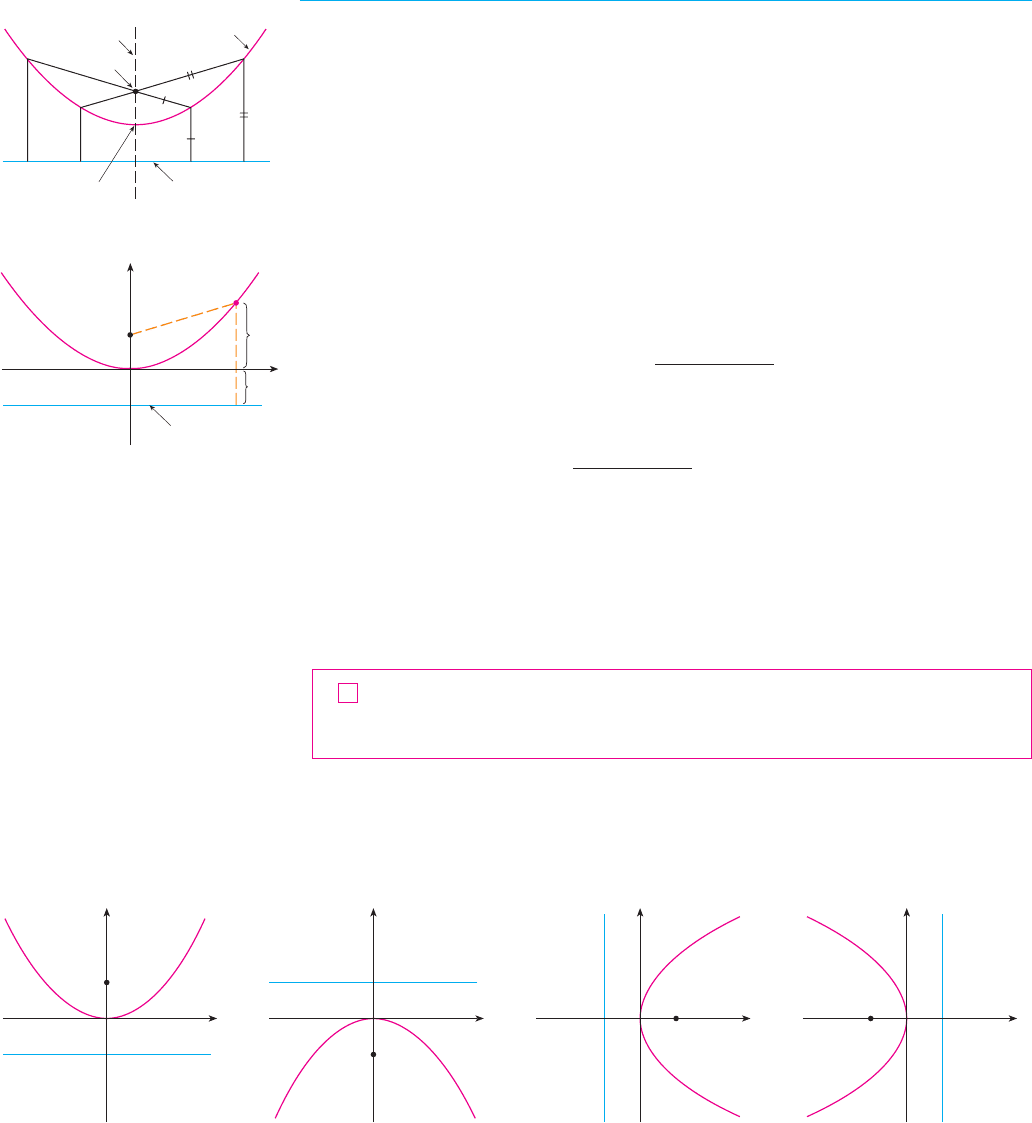
PARABOLAS
A parabola is the set of points in a plane that are equidistant from a fixed point (called
the focus) and a fixed line (called the directrix). This definition is illustrated by Figure 2.
Notice that the point halfway between the focus and the directrix lies on the parabola; it is
called the vertex. The line through the focus perpendicular to the directrix is called the
axis of the parabola.
In the 16th century Galileo showed that the path of a projectile that is shot into the
air at an angle to the ground is a parabola. Since then, parabolic shapes have been used
in designing automobile headlights, reflecting telescopes, and suspension bridges.
(See Problem 16 on page 202 for the reflection property of parabolas that makes them so
useful.)
We obtain a particularly simple equation for a parabola if we place its vertex at the ori-
gin and its directrix parallel to the -axis as in Figure 3. If the focus is the point ,
then the directrix has the equation . If is any point on the parabola, then the
distance from to the focus is
and the distance from to the directrix is . (Figure 3 illustrates the case where
.) The defining property of a parabola is that these distances are equal:
We get an equivalent equation by squaring and simplifying:
An equation of the parabola with focus and directrix is
If we write , then the standard equation of a parabola (1) becomes .
It opens upward if and downward if [see Figure 4, parts (a) and (b)]. The
graph is symmetric with respect to the -axis because (1) is unchanged when is replaced
by .
F I G U R E 4
0
x
y
(p,0)
x=_p
(d) ¥=4px, p<0
0
x
y
(p,0)
x=_p
(c) ¥=4px, p>0
0
x
y
(0, p)
y=_p
(b) ≈=4py, p<0
0
x
y
(0, p)
y=_p
(a) ≈=4py, p>0
$x
xy
p
%
0p + 0
y ! ax
2
a ! 1'!4p"
x
2
! 4py
y ! $p!0, p"
1
x
2
! 4py
x
2
( y
2
$ 2py ( p
2
! y
2
( 2py ( p
2
x
2
( !y $ p"
2
!
-
y ( p
-
2
! !y ( p"
2
s
x
2
( !y $ p"
2
!
-
y ( p
-
p + 0
-
y ( p
-
P
-
PF
-
!
s
x
2
( !y $ p"
2
P
P!x, y"y ! $p
!0, p"xO
F
SECTION 11.5 CONIC SECTIONS
|| ||
691
axis
F
focus
parabola
vertex
directrix
F I G U R E 2
F I G U R E 3
x
y
O
F(0,p)
y=_p
P(x,y)
y
p
